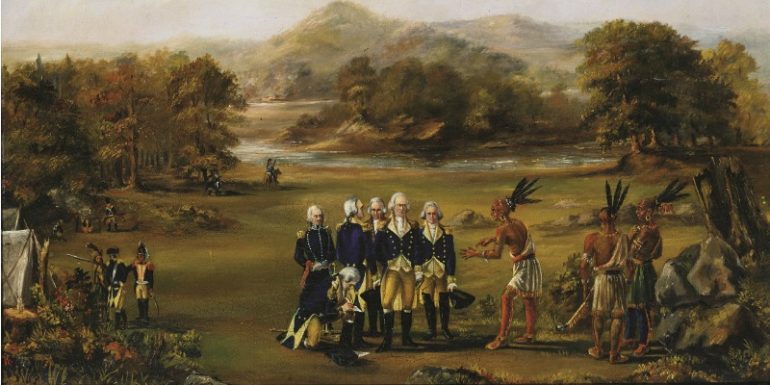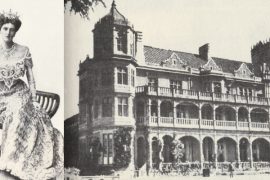By Sarah T. Lahey | Photo courtesy of the Chicago Historical Museum, ICHi-64806
In the summer of 1931, a group of Potawatomi traveled over 90 miles from Forest County, Wisconsin, to attend the Geneva Lake Centennial. The event celebrated 100 years of white settlement at the lake, and the Potawatomi were invited to participate. They were asked to set up a traditional camp and perform native dances in full regalia.
For the Potawatomi, the centennial would not have been a happy occasion. It marked the anniversary of Indian Removal — of being sent to live in remote areas on tiny reservations. It ignored leaders such as Big Foot who fought against the U.S. government for years, striving for independence. All things considered, the Geneva Lake Centennial must have felt like a slap in the face.
So, why did the Potawatomi come back? Perhaps they wanted to return to this beautiful lake, even under such conditions. Or, maybe they wanted the people of Lake Geneva to know they still existed. The Potawatomi had not disappeared or vanished; they were alive and well, still living in Wisconsin and preserving their way of life.
THE HEIGHT OF POWER
As covered in the summer issue of this magazine, the Potawatomi were at the height of their power when the U.S. government began its push for Indian Removal. During the 1700s, the Potawatomi numbered over 3,000 and had territory running from Detroit to Chicago to Milwaukee. According to Ann Keating, author of Rising Up from Indian Country, the Potawatomi controlled 18 million acres of land by 1790.
Their domain included Lake Geneva, where 500 Potawatomi lived in relative peace and prosperity. The Prairie Potawatomi, as they were known, were less militant than their tribal brothers in Michigan. As far as we know, they did not participate in any major wars of the 18th century.
The conclusion of the Revolutionary War in 1783, however, brought major changes. The newly formed U.S. government began to work on key initiatives — like taking valuable land in the Midwest. This created a flurry of fighting, and soon the American frontier became rife with bloodshed.
GREENVILLE TREATY OF 1795
The first major victory for the Americans was the Greenville Treaty of 1795, which granted large sections of Ohio and other locations to the U.S. government. To be clear, the Potawatomi, Ottawa, and Chippewa were very hesitant about signing this treaty. They did not want to give up their land, but they wanted to put a halt to constant warfare in the Midwest.
The Potawatomi trusted U.S. officials who promised this would be the one and only treaty ever needed to establish peace. In fact, the original treaty read: “Henceforth all hostilities shall cease; peace is hereby established, and shall be perpetual; and a friendly intercourse shall take place, between the said United States and Indian tribes.”
The Greenville treaty, full of false promises, also stated the U.S. government would never again ask for land in the Great Lakes region.
In that case, the Potawatomi were looking pretty good. The treaty asked them to give up six square miles at the mouth of the Chicago River, along with some settlements near Fort Wayne. This was a small sacrifice to pay for the ability to keep nearly 18 million acres.
THE FALLOUT
What happened next, of course, was not what they expected. When Thomas Jefferson took office in 1801, all standing agreements were overturned. It was as if the Greenville Treaty never existed. Jefferson wanted more land, and he authorized his agents to take it by any means possible.
First, negotiation tactics took a turn for the worse. U.S. agents brought large quantities of whisky to negotiations and accepted drunken signatures. They also allowed the chiefs present to sign on behalf of others who were absent. Considering that cash bribes were common during negotiations, this was a major problem.
Tensions increased leading into the War of 1812. Although this was a conflict between the British and Americans, most battles were fought between the U.S. and native tribes allied with the British (who were, incidentally, quite busy fighting the Napoleonic Wars).
In the Chicago area, the Potawatomi took a leading role. They allied with the British who supported the formation of a large Native American “state” in the Midwest. This would stop American expansion, and — for the Potawatomi — offered a chance to preserve native homelands.
BATTLE OF FORT DEARBORN
Sometime before or during the War of 1812, Chief Big Foot became leader of the Lake Geneva Potawatomi. Some reports have him ruling as early as 1803. Big Foot did not like white settlers or their influence on his people. And, unlike previous leaders of the Prairie Potawatomi, he was ready to fight.
The Lake Geneva Potawatomi participated in one of the earliest battles of the War of 1812: the Battle of Fort Dearborn, sometimes known as the Chicago Massacre. Most local histories omit this key fact, perhaps unwilling to believe that Big Foot’s people ever militarized against the U.S.
However, Big Foot’s great-grandson, Clearwater, provided the Potawatomi perspective. In an article from the Racine Journal Times, dated August 1933, Clearwater wrote: “I do not deny or doubt that he [Big Foot] and his band took part in the Fort Dearborn massacre.”
The battle was an early victory for the British, who were represented by the Potawatomi. In the attack, more than 1,000 Potawatomi attacked a group of soldiers and their families marching out of Fort Dearborn. Over 50 men and women were killed, the fort was burned to the ground, and several Americans were taken prisoner.
After the Battle of Fort Dearborn, Big Foot spent the next 20 years contemplating attacks against U.S. Like a simmering pot, he was always ready to boil yet never reached peak temperature. Although he and his men posed a credible threat, they did not participate in any more battles.
SECRET AGENTS AT FONTANA
Big Foot’s talk of war raised alarms with the Office of Indian Affairs at Chicago. In fact, the U.S. felt it necessary to send spies to Fontana to monitor war-like activity. Agents were first sent during the Winnebago War of 1827 and again during Black Hawk’s War of 1832.
The first spy was Shabbona, a Potawatomi chief who “turned” and became loyal to the Americans. In his secret missions, Shabbona was assisted by Sauganash, the son of a British officer and a Potawatomi woman. Together, Shabbona and Sauganash served a dual purpose: they scouted Big Foot’s village for any signs of war, and tried to convince the chief to pursue peace. In the latter cause, they were successful. Big Foot’s men did not fight in the Winnebago War or Black Hawk’s War.
Shabbona took things a step further in 1832. After visiting Fontana and convincing Big Foot to stay out of Black Hawk’s War, he rode up and down the Illinois River to warn settlers of impending attacks. He saved hundreds of lives in what became known as “Shabbona’s Ride.” He also put Black Hawk’s warriors at great risk and effectively ended the war before it started.
Shabbona and Sauganash are honored today in Fontana’s Country Club Estates, with the street names Shabbona Drive and Sauganash Drive. Many who live here are familiar with these roads, but we have to wonder: Did those who named the roads know they honored traitors and spies?
CHICAGO TREATY OF 1833
The failure of Black Hawk’s War sealed the fate of Native Americans in the Midwest. There were no more battles. The U.S. had won the fight of Indian removal. And, without further ado, the U.S. government negotiated the deal of the century.
The Chicago Treaty of 1833 treaty “sold” all of Chicago and southeastern Wisconsin (including Geneva Lake) to the U.S. government at the bargain price of $16,000 paid annually to the Potawatomi, or about $400,000 in today’s dollars. Considering that a single average lakefront home on Geneva Lake costs over $2,000,000, this was not a fair deal.
Chief Big Foot did not sign the Chicago Treaty, although he was tribal leader at the time. This suggests he refused the treaty, which gave him three years to vacate his land. Indeed, if it were not for a sudden tragedy, he may never have left Fontana.
In 1835 and 1836, a horrible round of whooping cough nearly decimated Big
Foot’s village. This was during the last months of allowed residence on Geneva Lake, under the terms of the Chicago Treaty. I have to imagine this epidemic altered Big Foot’s state of mind. If he had been pondering a final revolt, this might have reversed his course. With fewer men to fight, what could he do?
BIG FOOT’S FAREWELL
According to reports of early settlers (those who were already in residence by the fall of 1836), Big Foot’s farewell to Geneva Lake was emotional. He first visited the graves of his deceased wives in Williams Bay, where he also said goodbye to a friendly settler named Israel Williams, whose name now marks the bay.
Big Foot then went to his council pole at Fontana and surveyed the lake one last time, a moment that has been memorialized by Jay Brost’s sculpture in Reid Park. The artist imagines the brooding emotions of the leader at this time — a man saying farewell to his beloved lake and home.
The next day, Big Foot led his people west. The U.S. government had offered “guides” to help on the journey, but Big Foot refused such help. Undoubtedly, he could navigate the trails better than any U.S. army officer and preferred to lead his people without an armed escort.
The Lake Geneva Potawatomi first went to reservations on the Platte River in Missouri. However, local settlers objected to their presence and Big Foot’s people disliked the climate. According to Arthur B. Jensens, they next went to Lawrence, Kansas. Many hated it there and returned to Northern Wisconsin. Some also fled to Canada, where the U.S. government could not reach them.
A RESOLUTE LEADER
As I reflect on the life of Big Foot, I am reminded of the words of Juliette Kinzie, a visitor to his village in 1831. She wrote in her memoir, referring to the Indians of Wisconsin:
“They did not love the Americans — why should they? By them they had been gradually dispossessed of the broad and beautiful domains of their forefathers, and hunted from place to place, and the only equivalent they had received in exchange had been a few thousands annually in silver and presents.”
Money was very little compensation for what was lost in terms of land, dignity, and tradition. Leaders such as Big Foot did not “love the Americans.” They were not friends with their colonizers. I call this article “Big Foot’s War” because that’s what Indian Removal was: a series of armed conflicts, large and small. Each treaty negotiation was a war settlement, not a peaceful compromise.
Chief Big Foot, a resolute leader, fought the forces of colonization for more than twenty years. He did not give up, but guided his people in the worst of circumstances. Although we cannot alter the course of history, we can honor Big Foot’s legacy by remembering the Potawatomi history of Geneva Lake.





